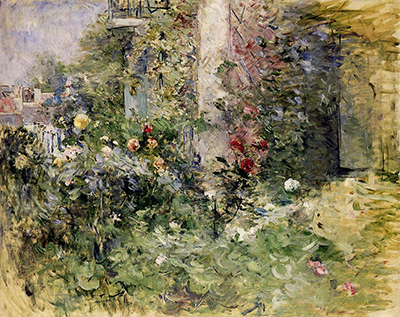Berthe Morisot completed The Garden at Bougival (le jardin a bougival) in 1884 and produced a large numbers of paintings in this location between the years of 1881 and 1884.
The artist rented a house in Bougival over this period and would spend each summer here, enjoying the large garden and relaxing with friends and family. This charming spot woud inevitably be used as inspiration for a number of paintings by Morisot, including most memorably The Fable, Julie and Eugene Manet, Red haired girl sitting on a veranda, The Garden at Bougival and Roses Trémières (Hollyhocks). They would feature a combination of the house and garden alone, or others with multiple figures added. Garden settings was common during the Impressionist period and enabled artists to make use of nature but without the difficulties of arranging a scene in the open countryside.
Two of the most famous Impressionist paintings set in gardens would probably have to be Garden at Sainte-Adresse and Claude Monet, The Bench by Edouard Manet. You may also remember another famous painting by Renoir set in the very same town - Dance at Bougival. In fact, the lives of these artists were so inter-connected that their families appear frequently within each other's careers in a variety of portraits. Another additional aspect to this work is that several members of the Impressionist movement were actually keen gardeners, often seeking an escape from city life in order to get amongst the plants and flowers of their gardens - perhaps Caillebotte was the keenest of them all, gifting us the likes of The Garden at Petit Gennevilliers and Les Orangers.
The precise address of this property was 4 Rue de la Princesse and it is now believed to be home to a medical practice. In the year of this particular painting Berthe had spent the summer here with her husband Eugene and her daughter Julie. They both appear in many of her paintings, with family and friends being the inspiration for much of her work. During this time in French society, female lives were dominated by these social circles, ensuring most female artists would concentrate on such topics. It was only later that women started to enjoy a great independance in their lives and this became reflected in the new types of art which they then delivered. That said, Morisot always tried to depict women's lives in a positive, powerful atmosphere in a form of celebration rather than focusing on what was not possible at that time.




